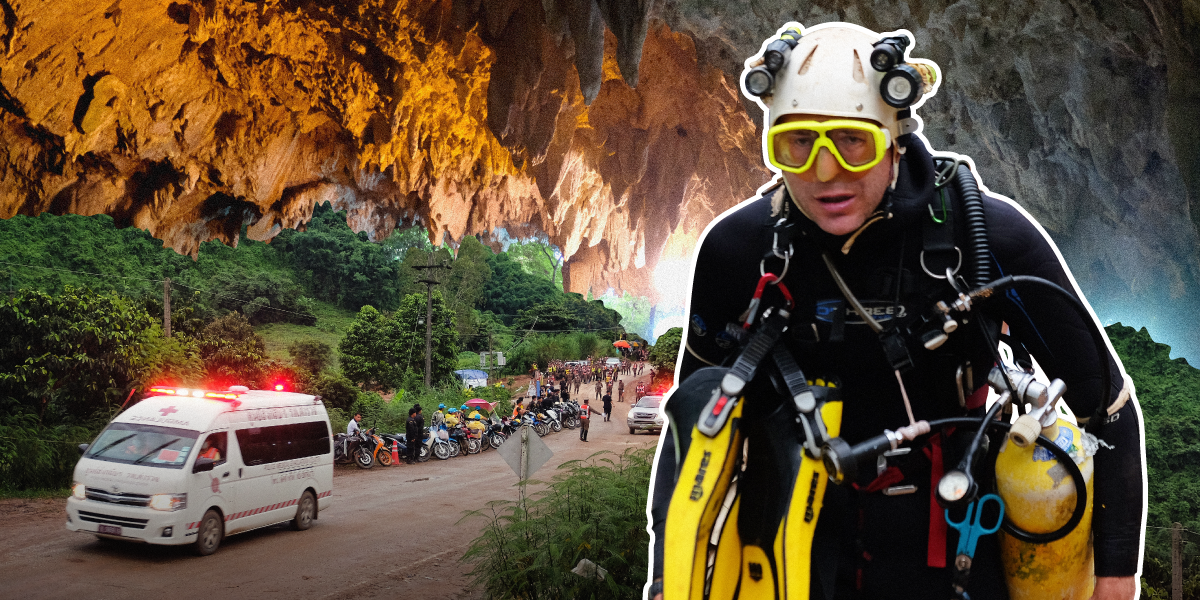- On June 23, 2018, 12 members of the Wild Boars soccer team and their coach entered caves in Northern Thailand to perform a ceremony.
- Things drastically changed when torrential rains caused flooding that trapped them all in the Tham Luang Nang Non cave system.
- Hundreds of rescuers from around the world teamed up to rescue the boys. It took nine days for the divers to find the boys and their coach. It took another eight days to rescue them all.
- After surviving with little food and water in the flooded cave, all of of the boys soccer team and their coach have since recovered after 17 days trapped in the cave. Here’s a timeline of how it all unfolded.
- Visit Businessinsider.com for more stories.
A year has passed since 12 young soccer players and their coach were trapped for 17 days in a flooded cave in Northern Thailand.
Book deals, a Netflix film, Thai citizenship, a defamation case, and boosted tourism have all resulted from the ordeal.
Here is a timeline showing exactly how the Thai soccer team rescue unfolded and what’s happened in the year since.
Saturday, June 23: 12 members of a Thai boys soccer team and their coach get trapped in the Tham Luang Nang Non cave by torrential rain.
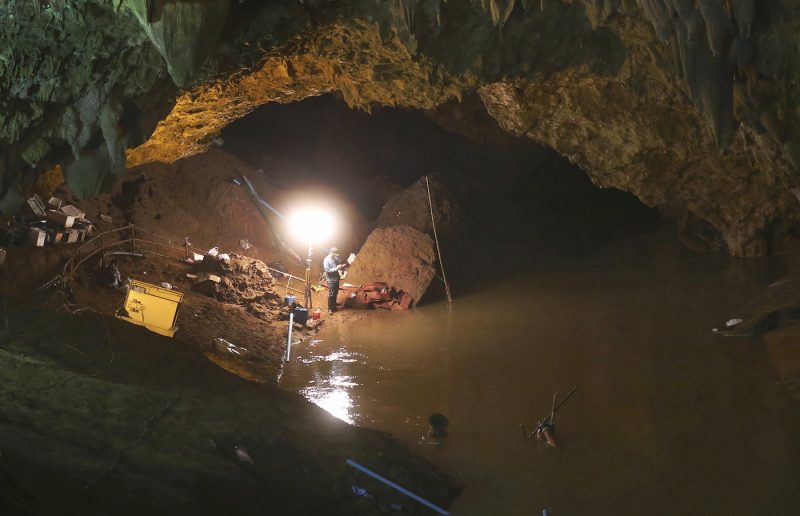
The boys were apparently performing a sort of initiation ceremony in the cave, and got stuck when the cave flooded, blocking their way out.
Park officials discover the boys' bikes at the entrance to the cave, and worried parents call the police when they realize their children are missing.
A major search and rescue operation is launched to find them.
Monday, July 2: The Thai soccer team and their coach are found showing "signs of life" after being trapped for nine days in the flooded cave.
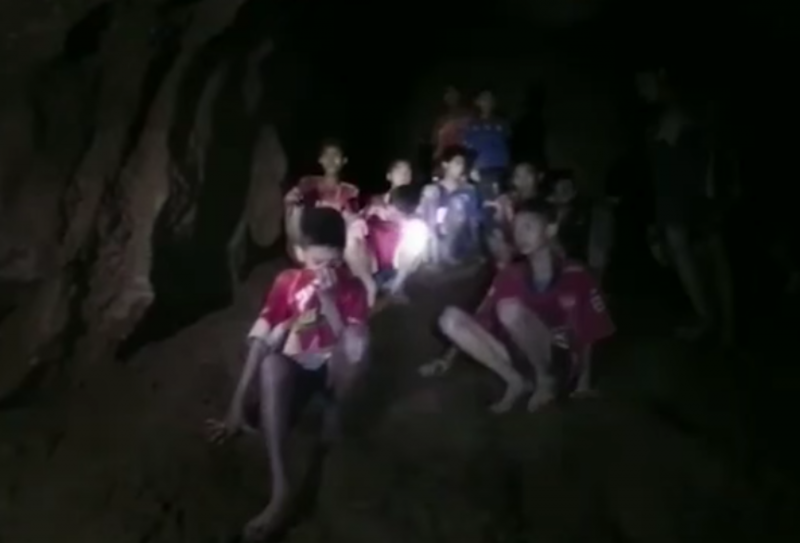
Nine days later, divers find all 12 boys and their coach, huddled together above the lapping water in the cave - 2.5 miles from the entrance.
The coach of the soccer team, Ekkapol Chantawong, taught his players how to meditate so they could stay calm and conserve energy while they waited to be rescued. Divers found the team meditating when they arrived at the cave.
Getting into the cave wasn't easy — and getting the team out would be even harder.
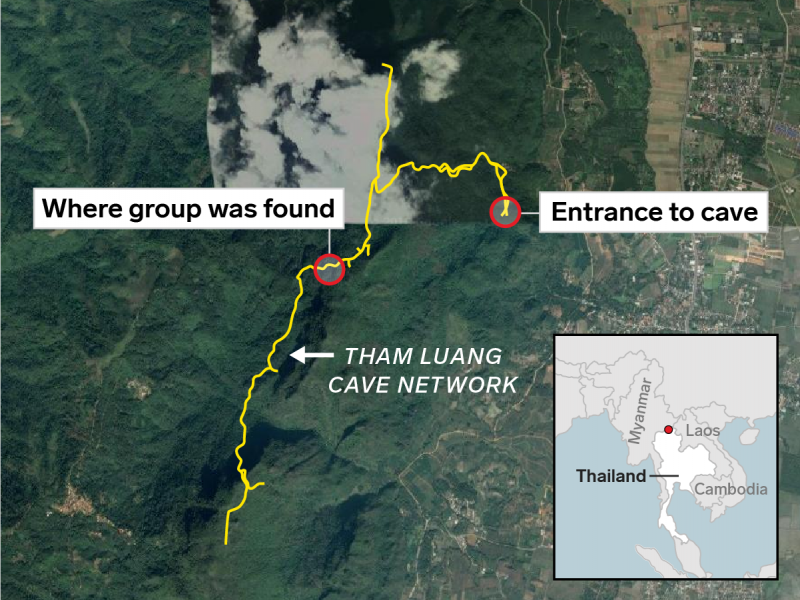
Thai Navy SEAL divers and rescue workers entered a narrow passageway after passing through a key chamber where high, murky waters had previously blocked their progress.
In the course of their search, rising water filled sections of the cave, repeatedly forcing them to withdraw for safety reasons.
When water levels dropped, the divers went forward with a more methodical approach, deploying a rope line and extra oxygen supplies along the way.
Tuesday, July 3: Rescuers prepare plans for getting the team out of the cave.
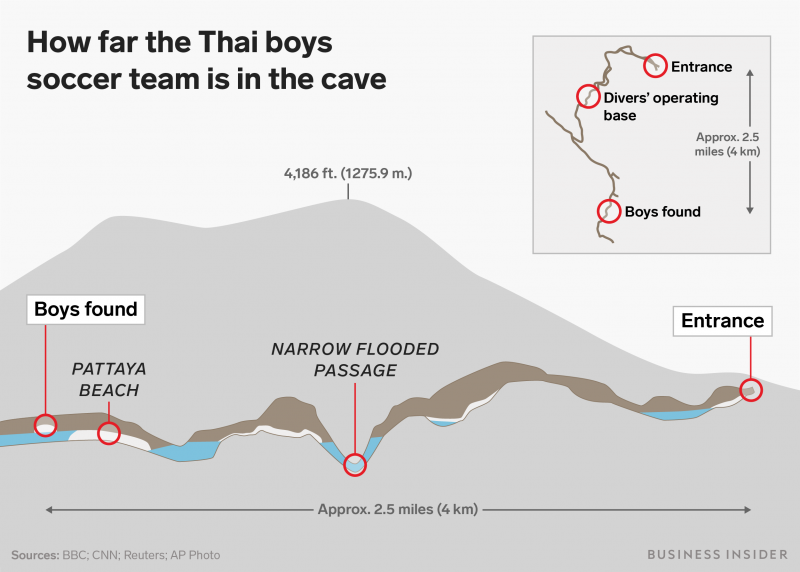
There are three options available: teach the boys to swim out with scuba gear, drag them out of the cave, or leave them with supplies to wait until the water drains away after the monsoon season ends in four months.
While they try to figure out the best option, divers and medical professionals stay with the boys and deliver medicine and food to increase their strength.
Wednesday, July 4: The team begins taking swimming and diving lessons.

Swim lessons are rare in Thailand, where the leading cause of death for children under 15 is drowning. So the boys had to learn how to swim and dive before they could start their journey out of the cave.
Thai Navy SEAL divers worked on installing a fiber-optic cable so the team could get on the internet and talk to their families.
Countries including Australia, Britain, China, Israel, and the United States begin providing resources and helping out in the rescue.
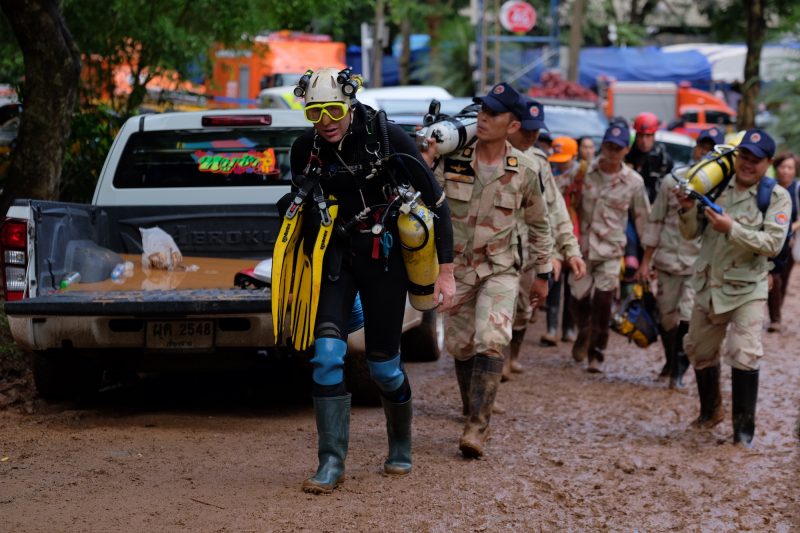
Three expert cave divers from the UK and a team of 30 divers from the US military's Indo-Pacific Command begin working with the Thai Navy SEALS. China and Australia also send experts and rescue workers to Thailand.
Israel's Maxtech Networks provide radio devices that helped rescuers maintain communication with the soccer team after they were discovered in the cave. The devices provided voice, data, and video access.
Thursday, July 5: Authorities drain water from the cave.

Rescuers can now enter the cave up until the third chamber, located about 1 mile from the cave's entrance without using scuba gear.
Hundreds of pumps drain floodwaters from the cave, and water levels are reduced about 40% in some areas. But miles of the tunnel is still full of water. According to The Guardian, about 3,400 gallons of water are being pumped out of the cave per hour.
If they can drain enough water out of the cave, the boys could maybe even walk out.
Experts worry the soccer team is not well enough to be moved from the cave yet.
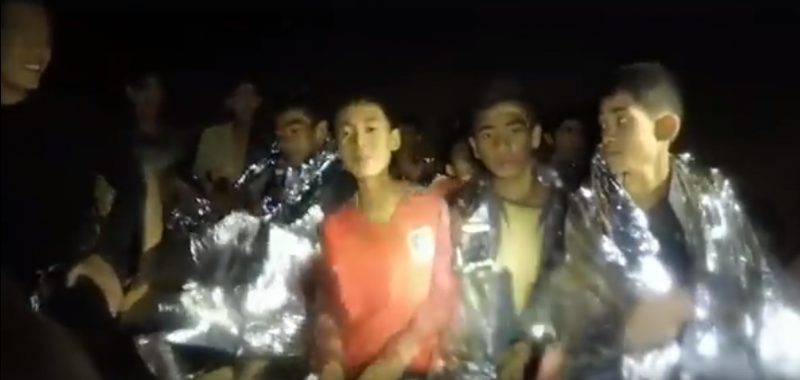
Oxygen is pumped into the cave to aid in their recovery. At least two of the boys and the coach are exhausted and malnourished.
Friday, July 6: A Navy SEAL working with the rescue team dies.
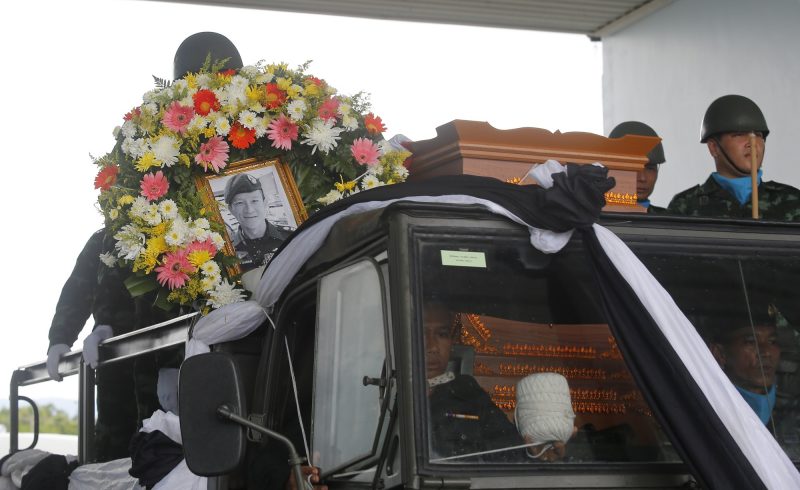
The diver, identified as 38-year-old Saman Kunan, had been delivering oxygen along the cave for the boys and coach, when he died due to lack of oxygen.
It was the only fatality from the rescue.
Saturday, July 7: Oxygen levels in the cave continue to drop as authorities become more concerned that it won't have enough time to save the team.
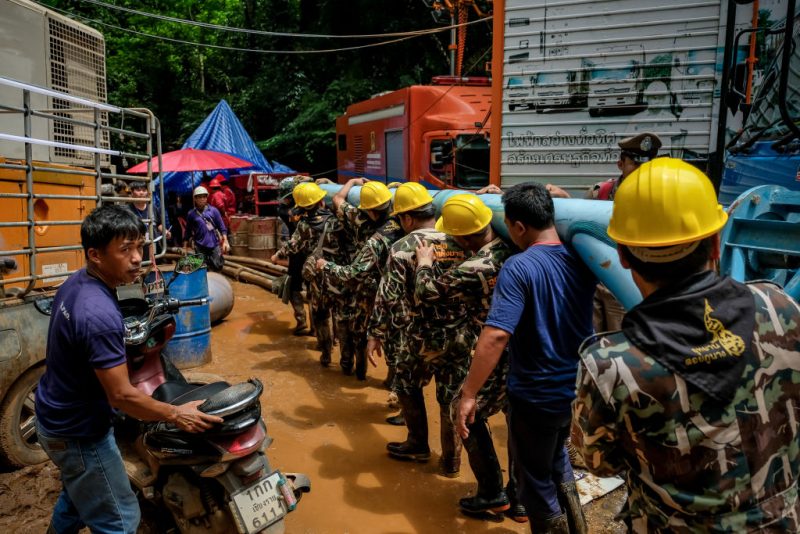
Oxygen levels in the cave have been quickly depleted by an influx of rescue workers in the cave, and levels in the area where the boys are trapped have dropped from the usual 21% to 15%.
Officials begin working to supply the boys and their coach with oxygen through a 3-mile cable running through the cave's winding chambers.
Sunday, July 8, 11 a.m.: A rescue operation begins to save the 12 boys and their coach from the cave.
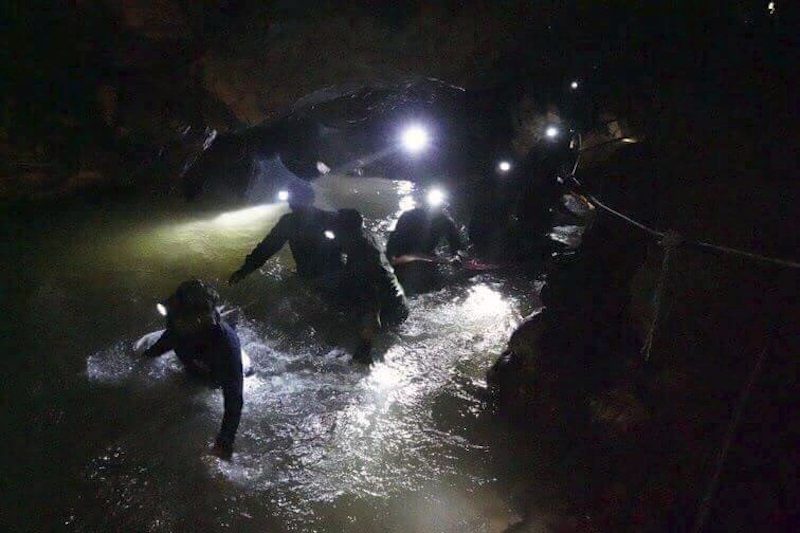
The only way to bring them out of the cave is by navigating dark and tight passageways filled with muddy water and strong currents. The path out is considered especially complicated because of twists and turns in narrow flooded passages, some only 2 feet wide.
About 0.6 miles of the journey out of the cave is underwater.

Two divers accompany each boy, guided by rope. The boys then walk from Chamber 3 to the mouth of the cave, which has been mostly drained over the last few days of the rescue operation.
For the trickier bits, the boys and their coach were heavily sedated withketamine, xanax, and atropine - a saliva suppressant - to keep them calm before cave divers pulled them out of the complex.
7:55 p.m.: The first four boys are out of the cave.
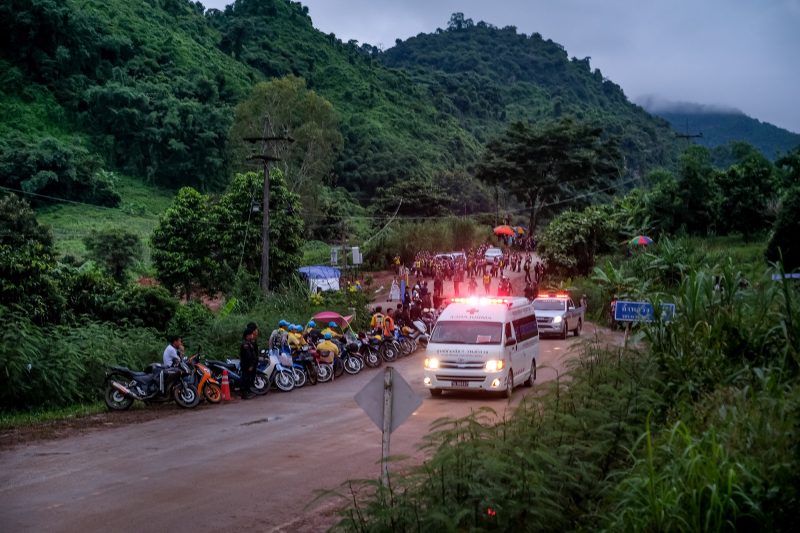
The four children were healthy and taken to the local hospital after being rescued. The rescue mission concludes for the night because of low oxygen levels.
Monday, July 9, 5 a.m.: Tesla and SpaceX CEO Elon Musk posts photos and video from inside the cave, but his rescue idea ultimately proves too complicated to be useful.
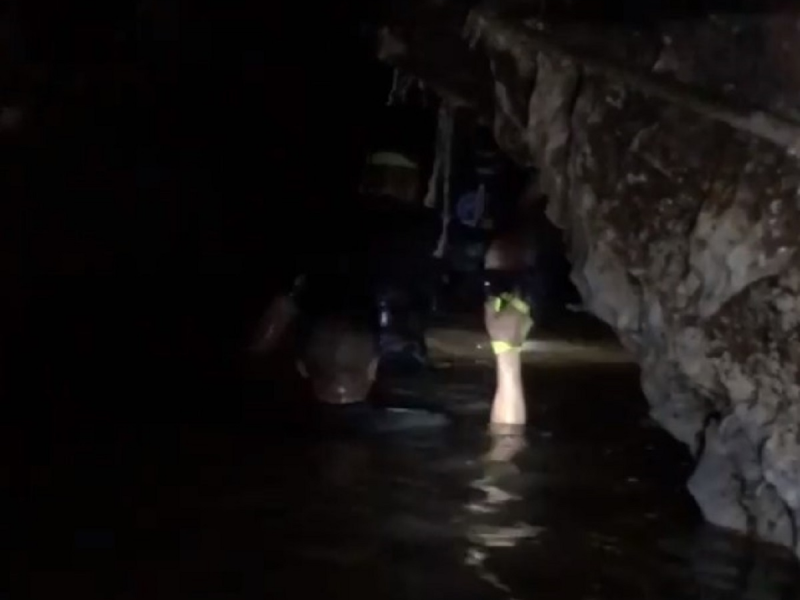
Elon Musk said on Twitter July 4 he was "happy to help" the Thai government in its rescue effort "if there is a way to do so", and continued to post about the rescue mission over the coming days.
Thai authorities and representatives for Musk begin discussing the possibility of using resources from Musk's companies to help rescue the boys' in the cave, including using technology from SpaceX, Tesla, or The Boring Company.
Musk suggests a series of tubes could be sent through the cave network and inflated, creating a tunnel for the team to travel through without needing to scuba dive. He later scraps that idea, and starts testing a "kid-size submarine" in Los Angeles to put the boys in and bring them out of the cave.
On Tuesday, Musk posts photos on his Twitter account from inside the cave. "Mini-sub is ready if needed," he wrote. "It is made of rocket parts & named Wild Boar after kids' soccer team."
Narongsak Osatanakorn, the Thai official leading rescue operations, said they didn't need Musk's sub.
"Although his technology is good and sophisticated, it's not practical for this mission," the rescue chief said.
9 p.m.: Four more boys are rescued from the cave, bringing the total to eight who have been rescued.
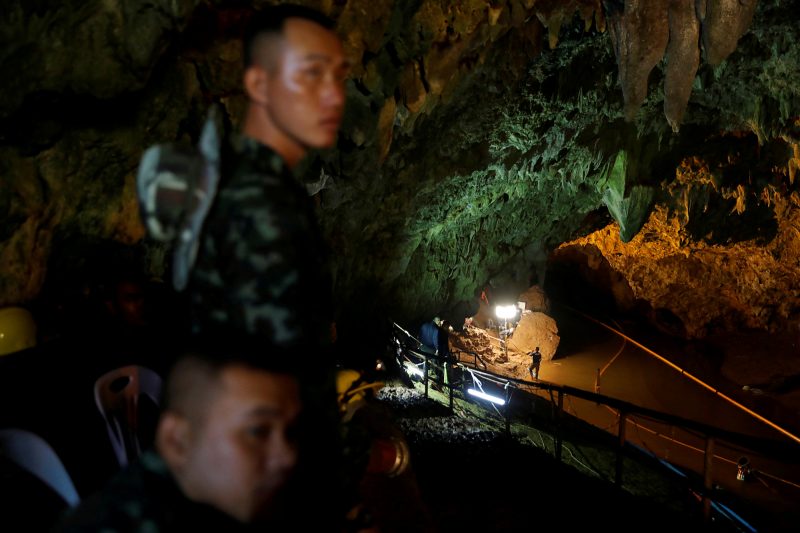
Some of the same rescue divers who got the boys out on Sunday went back in on Monday. They would have traversed about 10 miles total on the two trips.
On the second day, four more boys make it out with the divers.
All eight boys are recovering in the hospital well and are expected to stay there for a week to get fully healthy.
Four of the boys and their coach remain stranded in the cave. The rescue team takes another break Monday night to rest and reset the oxygen tanks.
Tuesday, July 10, 6:38 pm: The remaining four boys and their coach are rescued from the cave.

All 13 members of the soccer team are now rescued out of the cave and safe. They join their teammates in recovery at the hospital.
They were in the dark for so long that they had to wear protective sunglasses when they emerged from the cave.
The world celebrates: "Mission accomplished."
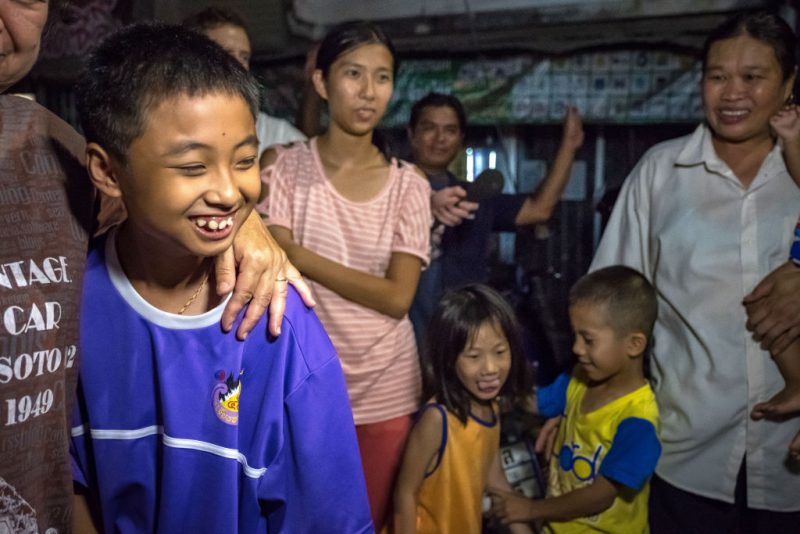
The world watched as the heroes found the boys, and successfully got them all out of the cave over three days of daring rescues. Tributes pour in as everyone celebrates their safe return.
"We are not sure if this is a miracle, a science, or what," the Thai Navy SEALs wrote on their Facebook page. "All the thirteen Wild Boars are now out of the cave."
Thai authorities held a celebratory press conference where they said: "We have done what others thought was impossible."
Wednesday, July 11: The soccer team recovers in the hospital.

Health officials are keeping the team in isolation for a few days, treating any cuts or scrapes they have, re-nourishing their bodies, and monitoring whether they develop lung infections from any fungi or bacteria in the cave.
Video shows them smiling and waving from their hospital beds.
After 17 days trapped inside the cave, they are safe.
July 18: Video shows the boys leaving the hospital for the first time.

The boys left the hospital in Chiang Rai after eight to 10 days of recovery, and attended their first press conference with their parents.
Video of the #ThaiCaveRescue boys leaving hospital in Chiang Rai. Pics by @Patrick_BKK @Channel4News @CNN pic.twitter.com/d0QsBBF9Ih
— Jonathan Miller (@Miller_Reports) July 18, 2018
August 8: Three of the boys, and their coach, are granted Thai citizenship and passports.

They were considered stateless, Reuters reported, and got citizenship after authorities reviewed their documents and determined they were born in Thailand.
Sometimes people who are "stateless" in Thailand lived in areas where national borders have changed, or are part of the "hill tribes" in remote areas, according to Reuters.
September 2018: British diver Vernon Unsworth files a defamation lawsuit against Elon Musk.
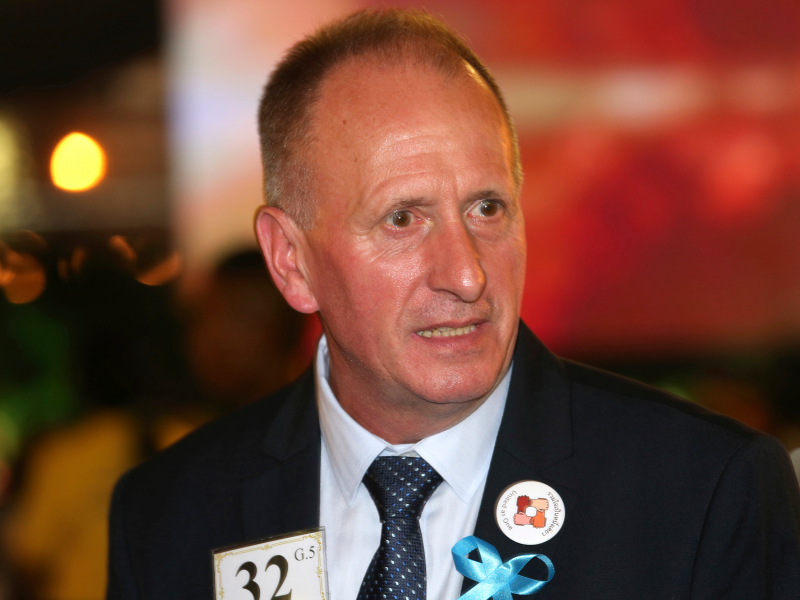
Vernon Unsworth alleged that Musk falsely accused him of being a pedophile on Twitter, when a fight developed between them after Unsworth criticized Musk in a television interview, The Guardian reported.
Musk's lawyers have argued that the tech mogul was merely sharing his opinion. The case is expected to go to trial in October, the Daily Beast reported.
October 2018: The Wild Boars travel the world to play soccer and tell their story.
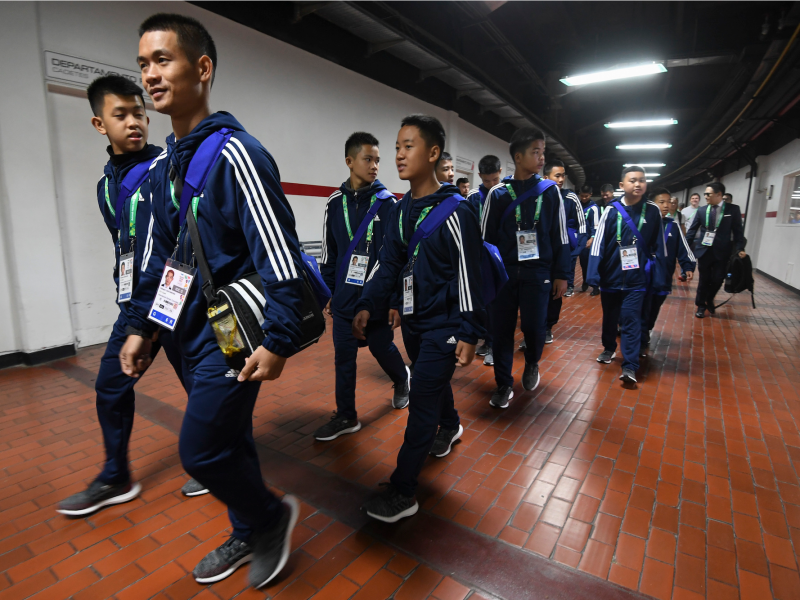
They also went on a short tour in the United States. As INSIDER's Susanna Heller reported, they went on the "Ellen" show and said they only intended to be in the cave for one hour - until things went wrong.
The boys explained how rising waters complicated the matter. "At the intersection inside the cave, they just saw that the water had risen too high. So they knew then that they wouldn't be able to get out," the translator said.
They had no food or water in the cave and said they subsisted off the clean water dripping off stalactites.
The team measured time in the cave with a digital watch one boy had. That's how they knew four boys had birthdays in the cave.
None of them remember being rescued, which they said was an eight-hour process for each person, because they were sedated.
Inside the cave, they didn't know anything that was happening outside. They knew they were supported, but they didn't realize the whole world was watching.
While they were in the cave, the boys "weren't scared and they always had hope." They said they mainly stayed calm because their coach told them to pray and meditate.
December 2018: A bronze statue of Navy SEAL diver Saman Gunan, who died during the operation, is installed in front of the cave.

A massive crowd reportedly turned out to pay tribute.
April 2019: Netflix announces a deal for a film about the rescue.

Netflix will join with the production company behind "Crazy Rich Asians" to make the film, the AP reported.
Jon M. Chu who directed "Crazy Rich Asians," will also direct this film.
Parts of the proceeds will go to the soccer team and to disaster relief charities.
The retelling of the story isn't limited to screens. Multiple books about the ordeal are published in the months after the rescue.
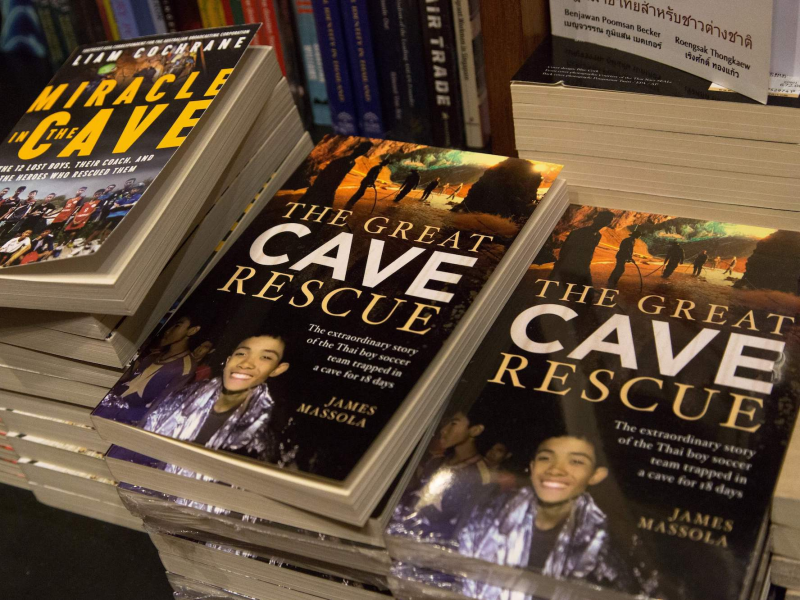
Multiple books have been published about the rescue, including one by ABC News chief national correspondent Matt Gutman's and another by Australian journalist James Massola.
June 2019: A year later, the boys, though wary of the media, are said to be doing just fine.

A local monk, Abbot Prayutjetiyanukarn, told The Associated Press that, while some of the boys were wary of media, they were fine.
"Both physically and spiritually, there's nothing to worry about," he said.
The cave and Mae Sai town have become tourist destinations.

The cave's surrounding features, which last year was mostly dirt roads and thick mud, have been renovated with facilities being built, roads paved, and shops settling in, Time reported.
Local souvenir shopkeepers said the boys' ordeal had boosted sales. Before the kids were trapped there were no shops, but now the area is a financial hub for the district.
June 23, 2019: To fundraise money for the area where they were trapped, the boys and their coach run a marathon.

About 4,000 people including nine of the Wild Boars and their coach - took part in a marathon and biking event to raise money to improve the Tham Luang cave complex, the AP reported.
The team also honors Navy SEAL Saman Gunan, who died during the rescue.

"This place is very important to us. Partly because of Lt. Saman, who is like a second father to us," one of the boys, 15-year-old Adul Sam-on, said at a news conference, DW reported.
"He was the one who helped us, and we need to remind ourselves that every day."
